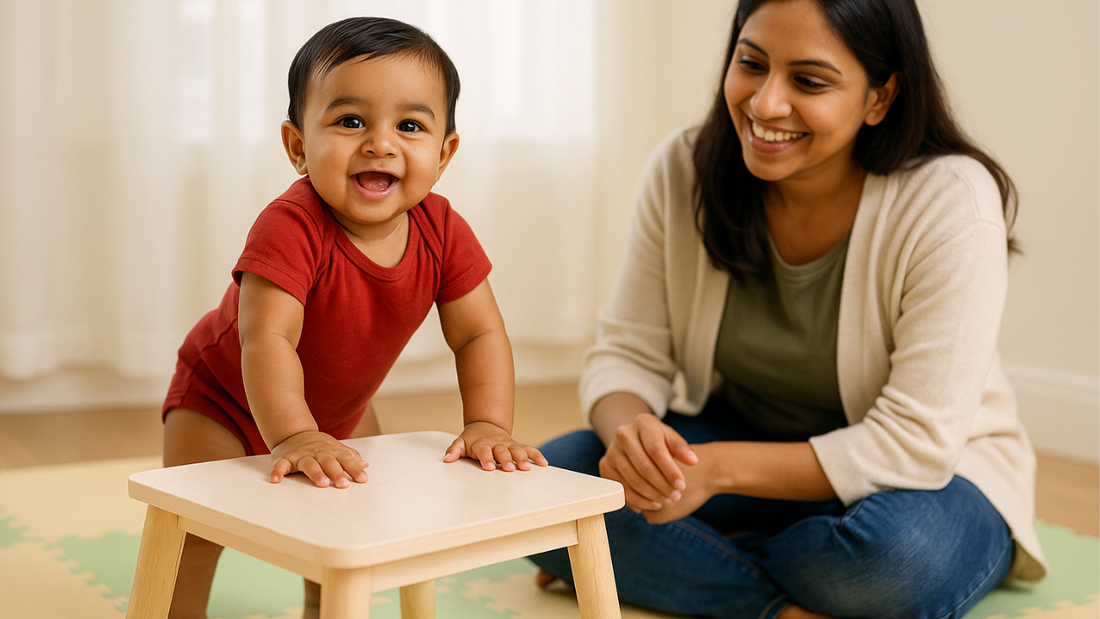
Month 10: Standing with Support- Helping Your Baby Explore the World
LiLLBUDBabies are getting stronger, braver, and more curious about the world by the time they are about 10 months old. Perhaps one of the most thrilling achievements at this stage is standing with support. This ability is a stepping stone towards independent walking and is significant gross motor development.
What "Standing with Support" Looks Like
At this age, a lot of babies can:
- Babies take support to stand up by this age. They can use furniture, a parent's arm, or anything else they can grab onto to pull themselves up to stand.
- While standing, hold on to a table, couch, or toy.
- While holding on to furniture for balance, move to the side or "cruise."
- Before sitting down, see if you can stand on your own for a few seconds.
This milestone really shows how strong their legs, core, and arms are, as well as how well they can balance and coordinate.
Why It Matters
- Standing with help is more than just a physical milestone. Also, this gives babies:
- More confidence and independence because they can explore from a higher place.
- Develops muscles: strengthening leg, back, and core muscles needed for walking
- Fosters cognitive skills: standing enables babies to grasp objects, learn spatial relationships, and explore safely.
- Pulling up, balancing, and holding onto things helps them plan their gross motor skills better.
How to Help Someone Stand Up with Help
Here are some tips to help your baby practice safely:
- Give them safe furniture: Strong tables, low couches, or activity tables that won't fall over easily.
- Provide hand support: Hold their hands and let them push or pull while standing.
- Encourage cruising: by putting toys just out of reach so they have to move sideways while holding onto furniture.
- Floor practice: Allow your baby to practice squatting, kneeling, and sitting to build leg and core muscles.
- Use push toys: Activity walkers or push carts provide support while promoting forward motion.
- Cheer and show: Give them praise for their efforts and show them how to stand to get them to try it themselves.
Tip: Watch them closely so they don't fall or bump into anything while they practice.
Tips for keeping babies safe while they stand
When babies start to stand up at 10 months, new risks come up, so safety is very important:
- Make sure your furniture is safe and get rid of anything that could fall over.
- Take away any sharp corners or things that could hurt them in their standing area.
- Don't leave small toys on the floor so you don't trip.
- Put soft mats where your baby stands often.
- Never leave babies alone near stairs or high ledges.
Month 10 Developmental Checklist\
Babies at this age start reaching big milestones. Look for these key changes:
- Pulling themselves: They pull up to stand using furniture. Sometimes they need a little help from you.
- Cruising along furniture while holding on for support
- Trying to bend, squat, or sit down without losing their balance
- Holding onto objects while standing
- Showing curiosity by reaching for toys that are a bit higher up
Remember, every baby is unique and grows at their own pace; some may stand up earlier or later than the 10-month mark.
Helping people feel confident and explore
Standing with help is the first step toward walking, climbing, and moving on their own. To help this growth happen:
- Celebrate every small win, like being able to hold on to furniture for a few seconds.
- Let them explore while you keep an eye on them.
- Instead of putting pressure on them, give them support.
- Give them different surfaces to walk on, like carpet, foam mats, or soft rugs, to help them improve their balance and coordination.
Key Takeaways
- Standing with help is a big step forward in gross motor skills, at about 10 months
- It develops muscle strength, balance, and coordination.
- Promote practice with safe furniture, hand-holding, cruising, and push toys.
- Always maintain baby-proofing and supervision.
- Appreciate each try. Every practice brings your baby closer to independent walking.

